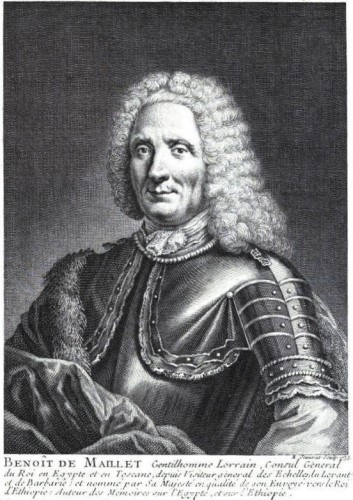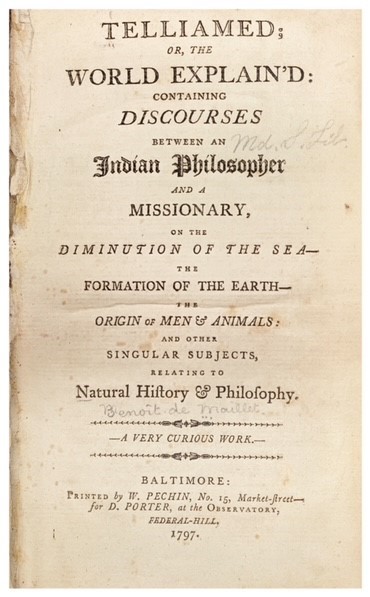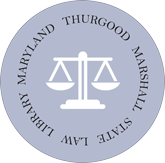
The Baltimore printed English translation of Benoit de Maillet’s Telliamed introduces itself in the title as a “Very Curious Work,” a fitting description considering the curious journey of its writing and publication. In Telliamed, a French missionary (the narrator) relays a conversation between himself and an Indian philosopher, for whom the manuscript was named. During the conversation the philosopher tells the missionary the true history of the earth. But, there was no Telliamed. De Maillet used the conversation to present unorthodox ideas (at the time) about the history of the earth's origins and the evolution of life by ascribing them to an exotic sage named Telliamed ("de Maillet" spelled backwards).
At the age of 35, de Maillet was appointed General Counsel of the king of France in Egypt. He occupied this position until 1708 and developed most of the ideas in Telliamed during his 16-year foreign assignment. Upon his return to France in 1720, various manuscript versions of Telliamed began circulating. In Telliamed de Maillet hypothesizes a naturalistic explanation for the earth's origins and the evolution of life, suggesting that the earth was once entirely covered by water and that all life originated from the sea. The origin of humans and animals are said to be due to transformation of species over time due to environmental factors. The ideas put forth by de Maillet in Telliamed propose a form of evolutionary theory long before Charles Darwin.
Between 1732 and his death in 1738 de Maillet worked with the Abbé Jean Baptiste de Mascrier to prepare Telliamed for publication. Recognizing that the ideas presented in Telliamed could be considered radical, even heretical, Mascrier reworked the text extensively in an attempt to reconcile it with Christian dogma. The first edition, issued in Amsterdam in 1748, was heavily expurgated. Still, it was sensational, and hence successful. Later editions were published in Basel (1749), the Hague-Paris (1755) and two English translations in London (1750) and Baltimore (1797).
The Thurgood Marshall State Law Library’s copy is the 1797 Baltimore printed edition. Albert Carozzi, in his chapter on De Maillet’s Telliamed in Eustasy: The Historical Ups and Downs of a Major Geological Concept indicates that this English translation “is a puzzle in American intellectual history because the persons and the reasons responsible for its publication remain unknown.”
While controversial in its time due to its departure from prevailing religious beliefs about creation and the age of the Earth, Telliamed contributed to the growing interest in natural history and the scientific investigation of the natural world during the Enlightenment period.

References:
Albert V. Carozzi, 1992. "Chapter 2: De Maillet’s Telliamed (1748): The diminution of the sea or the fall portion of a complete cosmic eustatic cycle", Eustasy: The Historical Ups and Downs of a Major Geological Concept, Robert H. Dott, Jr., Geological Society of America, 1992
Linda Hall Library. Scientist of the Day – Benoit de Maillet. https://www.lindahall.org/about/news/scientist-of-the-day/benoit-de-maillet/. Accessed on April 16, 2024.
Image courtesy of Wikimedia Commons. https://en.m.wikipedia.org/wiki/File:Beno%C3%AEt_de_Maillet.jpg File accessed on April 16, 2024.

